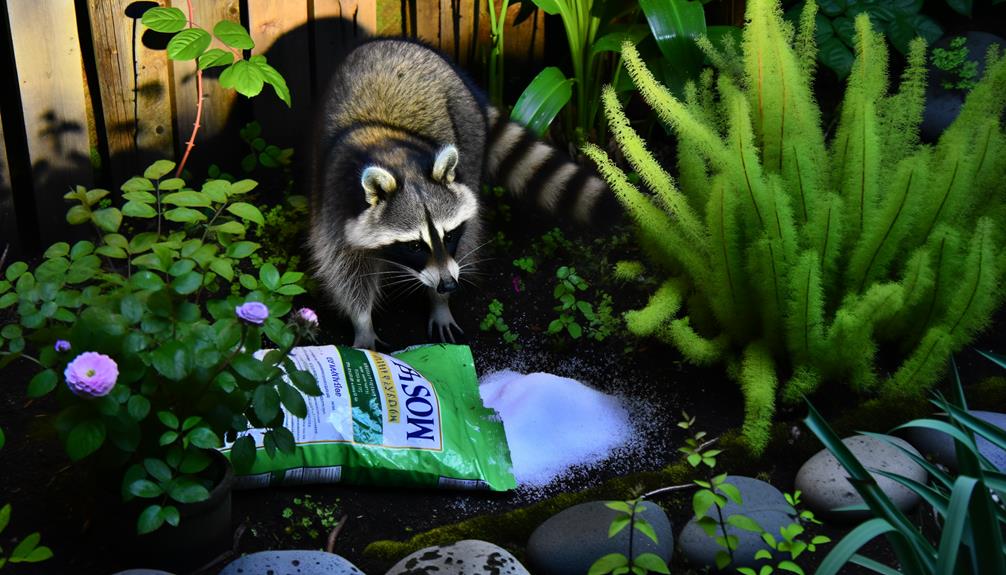Does Epsom Salt Get Rid of Raccoons?
Epsom salt, composed of magnesium sulfate, can deter raccoons by making gardens and entry points unpalatable. When spread around perimeters or mixed with water and sprayed, Epsom salt disrupts a raccoon's sensory mechanisms through its taste and texture.
However, the effectiveness is variable, with empirical data showing mixed results and frequent reapplication needed, especially after rain. As a non-toxic, practical solution, it can complement other pest management strategies.
For a deeper understanding of how to effectively utilize Epsom salt and other deterrents in managing raccoon activity, additional information is essential.

Key Takeaways
- Epsom salt deters raccoons by creating an unpalatable environment through taste, texture, and smell.
- Spread Epsom salt around garden perimeters or entry points to discourage raccoon activity.
- Reapply Epsom salt weekly or after heavy rain to maintain its repellent effect.
- Empirical data on Epsom salt's effectiveness is limited, with mixed success reported.
- Epsom salt is a non-toxic, practical solution for wildlife management but may require supplemental deterrents.
What Is Epsom Salt?
Epsom salt, scientifically known as magnesium sulfate, is a chemical compound composed of magnesium, sulfur, and oxygen, commonly utilized for its wide-ranging therapeutic and horticultural applications.
This crystalline substance is renowned for its high solubility in water, facilitating its absorption and effectiveness in various applications. In the medical field, magnesium sulfate is frequently employed to alleviate muscle soreness, reduce inflammation, and detoxify the body. Its efficacy is rooted in its ability to enhance mineral absorption through the skin.
In horticulture, Epsom salt serves as an essential nutrient supplement, promoting plant growth and improving soil quality by providing essential magnesium. Understanding the chemical properties and benefits of Epsom salt is vital for leveraging its full potential in diverse practical scenarios.
Common Uses of Epsom Salt
Among its myriad applications, magnesium sulfate is commonly utilized in both medical and agricultural contexts for its therapeutic and nutritive properties.
Medically, Epsom salt is renowned for its efficacy in alleviating muscle soreness, reducing inflammation, and promoting relaxation through transdermal magnesium absorption. It is often employed in bath soaks and compresses, providing symptomatic relief for conditions such as arthritis and fibromyalgia.
Agriculturally, Epsom salt serves as an essential magnesium supplement, enhancing plant growth and correcting magnesium deficiencies in soil. It is particularly beneficial for crops like tomatoes, peppers, and roses, promoting stronger root development and increased chlorophyll production.
Additionally, Epsom salt can be used to deter pests, making it a multifunctional tool in both healthcare and gardening practices.
Raccoon Behavior and Habits
Understanding raccoon behavior and habits is critical for effectively utilizing Epsom salt as a deterrent in pest management strategies. Raccoons are nocturnal, highly adaptable omnivores with a keen sense of smell, often drawn to residential areas by easily accessible food and shelter.
They exhibit dexterous forepaws, enabling them to manipulate objects, open containers, and access homes through small openings. Their habitual foraging often leads them to gardens, trash bins, and pet food.
Additionally, raccoons are territorial and may establish dens in attics, chimneys, or under decks. Recognizing these behavioral patterns allows for strategic placement of Epsom salt, capitalizing on its aversive properties to mitigate raccoon activity effectively.
Hence, comprehending raccoon habits is indispensable for successful deterrent implementation.
Why Raccoons Raid Yards
Raccoons raid yards primarily in search of accessible food sources, exploiting gardens, trash bins, and pet food as convenient foraging sites. These nocturnal creatures possess highly developed dexterity and intelligence, enabling them to open containers and navigate barriers with ease.
Their acute sense of smell guides them to potential food, often leading to significant property damage and sanitation issues. Additionally, raccoons are opportunistic feeders, consuming a variety of items such as fruits, vegetables, insects, and small animals.
To mitigate these invasions, homeowners should implement secure waste management practices, remove attractants, and fortify vulnerable entry points. Understanding raccoon foraging behavior is essential for developing effective, humane deterrent strategies to protect residential areas and maintain ecological balance.
Epsom Salt as a Deterrent
Epsom salt acts as a deterrent for raccoons by creating an unpalatable environment, effectively reducing their interest in the treated areas.
The application methods vary but typically involve spreading the salt around garden perimeters or mixing it with water to spray on affected zones.
This approach leverages the natural aversion of raccoons to magnesium sulfate, making it a practical and non-toxic solution for wildlife management.
How Epsom Salt Works
The efficacy of magnesium sulfate, commonly known as Epsom salt, as a deterrent lies in its ability to disrupt the sensory mechanisms and natural behaviors of raccoons. When raccoons encounter Epsom salt, its bitter taste and gritty texture create an unpleasant experience, discouraging them from frequenting treated areas.
Additionally, the strong odor of magnesium sulfate can interfere with raccoons' keen sense of smell, which they rely on for foraging and exploring their environment. By targeting these sensory inputs, Epsom salt acts as both a physical and olfactory barrier.
This dual-action deterrent mechanism makes Epsom salt an effective, humane option for those seeking to protect their property and maintain a raccoon-free environment.
Application Methods Explained
To effectively utilize Epsom salt as a deterrent, it is crucial to understand the precise application methods that enhance its effectiveness in repelling raccoons.
In the first place, create a perimeter barrier by sprinkling a generous amount of Epsom salt around gardens, trash bins, and entry points. Reapply after rain or heavy dew to maintain potency.
In the next place, dissolve Epsom salt in water (approximately one cup per gallon) and spray the solution on plants and potential raccoon pathways. This method ensures prolonged deterrence while minimizing plant damage.
Lastly, combine Epsom salt with other natural repellents like vinegar for enhanced effectiveness. These application techniques are designed to serve the community by providing a humane, environmentally-friendly solution to raccoon disturbances.
Scientific Basis
Understanding the scientific basis for using magnesium sulfate, commonly known as Epsom salt, necessitates exploring its chemical properties and physiological effects on raccoons.
Magnesium sulfate exerts a desiccating effect, which can disrupt the mucous membranes of animals, leading to irritation. In addition, its bitter taste acts as a natural deterrent, discouraging raccoons from frequenting treated areas.
The compound's hygroscopic nature aids in absorbing moisture, thereby creating an inhospitable environment for these nocturnal creatures. Moreover, raccoons have a heightened sense of smell, and the strong scent of Epsom salt can be off-putting.
Application Methods
To effectively utilize Epsom salt as a deterrent for raccoons, it is important to take into account best application methods. One technique involves sprinkling Epsom salt directly in areas frequented by raccoons. Another effective method is creating salt barriers around entry points. Both techniques leverage the raccoons' natural aversion to the taste and texture of the salt. Proper distribution and maintenance are essential to guarantee persistent efficacy and minimize re-infestation risks.
Sprinkling Epsom Salt Outdoors
One effective method for deterring raccoons involves evenly spreading a thin layer of Epsom salt around the perimeter of your garden or trash cans. To achieve the best results, make sure the salt is applied uniformly to create a consistent deterrent.
The magnesium sulfate in Epsom salt creates an unappealing environment for raccoons, interfering with their sense of smell and taste. Reapply the salt after rainfall or heavy dew to maintain its effectiveness.
For a sustainable approach, consider using a salt shaker or a garden spreader to control the application rate. Regular monitoring and reapplication can effectively discourage raccoons from frequenting protected areas, thereby safeguarding your property and contributing to a harmonious living environment for all.
Creating Salt Barriers
Establishing effective salt barriers involves strategic placement and specific application techniques to maximize the deterrent effect of Epsom salt against raccoons.
To construct these barriers, identify entry points and pathways frequently used by raccoons. Distribute a continuous line of Epsom salt along these routes, ensuring coverage is dense enough to create an unbroken deterrent.
For enhanced efficacy, apply the salt after periods of rainfall or irrigation, as moisture activates the magnesium sulfate, intensifying its repellent properties. Reapply weekly or after heavy precipitation to maintain the barrier's integrity.
Additionally, consider integrating Epsom salt into garden beds and around structural bases to fortify these areas. This approach provides a non-toxic, humane solution to raccoon intrusions, promoting harmonious human-wildlife coexistence.
Effectiveness Reports
Multiple studies and anecdotal reports have been evaluated to determine the efficacy of Epsom salt as a deterrent for raccoons. The findings are mixed, with some indicating moderate success in repelling raccoons, while others show negligible impact. Empirical data is limited, and more rigorous, controlled studies are required to draw definitive conclusions. However, field observations suggest that Epsom salt, when used appropriately, can serve as a supplemental deterrent.
| Source | Effectiveness | Notes |
|---|---|---|
| Study A | Moderate | Epsom salt reduced raccoon activity by 30% |
| Study B | Low | No significant change in behavior |
| Anecdotal C | High | Users reported fewer raccoon encounters |
| Anecdotal D | Mixed | Results varied by environment |
Practical application should consider the specific context and limitations of using Epsom salt.
Alternative Repellents
In exploring alternative repellents for raccoons, it is important to take into account substances like ammonia-based solutions, predator urine, and motion-activated sprinklers, each offering distinct mechanisms of action.
Ammonia-based solutions mimic the smell of predator urine, deterring raccoons through olfactory aversion. Predator urine, available commercially, exploits raccoons' natural fear responses, thereby creating an inhospitable environment. Motion-activated sprinklers deliver an unexpected burst of water, leveraging the element of surprise to scare raccoons away without harm.
These methods require consistent application and strategic placement for best efficacy. Utilizing these repellents can form part of a thorough raccoon management strategy, ensuring that humane and effective measures are employed to safeguard your property and serve the community's well-being.
Safety Considerations
When implementing raccoon repellents, it is crucial to take into account the safety implications for both humans and non-target animals. Epsom salt, while generally safe, can pose risks if ingested in large quantities by pets or children. Proper application techniques and safe storage must be prioritized to minimize any potential hazards. Below is a table illustrating key safety considerations:
| Safety Aspect | Potential Risk | Mitigation Strategy |
|---|---|---|
| Ingestion by Pets | Gastrointestinal distress | Store securely, apply sparingly |
| Human Contact | Skin irritation | Use gloves during application |
| Environmental Impact | Plant damage | Dilute solutions, target application |
| Wildlife Interaction | Non-target species affected | Monitor and limit exposure |
| Storage Concerns | Accidental spills | Keep in labeled, sealed containers |
Effective safety measures guarantee humane and responsible raccoon deterrence.
Final Thoughts
To summarize, while Epsom salt can be a practical and effective deterrent for raccoons, it is important to weigh its efficacy against alternative solutions.
Additionally, the safety of pets and other non-target animals must be carefully considered to avoid unintended harm.
Practicality and Effectiveness
Evaluating the practicality and effectiveness of Epsom salt as a raccoon deterrent necessitates a thorough understanding of both its chemical properties and the behavioral patterns of raccoons. Magnesium sulfate, the primary component of Epsom salt, is known for its deterrent qualities in various pest control scenarios. However, its utility in deterring raccoons remains inconclusive and variable.
Key considerations include:
- Application method: Requires frequent reapplication, especially after rain.
- Coverage area: Effective only in confined spaces.
- Behavioral adaptation: Raccoons may become accustomed to the scent.
- Cost-effectiveness: Potentially expensive for large areas.
- Environmental impact: Minimal, but requires responsible usage.
Alternative Solutions Considered
Exploring other options to Epsom salt for raccoon deterrence reveals a range of choices, each with distinct advantages and limitations.
Motion-triggered sprinklers, for instance, use sudden water bursts to startle and drive away raccoons effectively.
Ultrasonic repellent devices emit high-pitched sounds, inaudible to humans but unsettling to raccoons, offering a non-intrusive deterrent.
Chemical repellents, like predator scent or ammonia-soaked cloths, rely on scent avoidance but may need frequent reapplication.
Physical obstacles such as mesh wire or electric fencing guarantee exclusion but can be labor-intensive.
Integrated pest management strategies, blending various methods, often produce the best outcomes in a thorough raccoon control plan.
Each alternative should be assessed for its feasibility, cost, and long-term effectiveness to ensure ethical and efficient raccoon management.
Safety for Pets
When considering the safety of pets, evaluating the non-toxic nature of Epsom salt as a deterrent for raccoons is crucial. Epsom salt, or magnesium sulfate, is generally regarded as safe for pets when used appropriately. However, there are specific precautions pet owners should take.
- Avoid ingestion: While non-toxic, consuming large amounts can cause gastrointestinal upset.
- Proper application: Use Epsom salt in areas inaccessible to pets to minimize risk.
- Monitor pets: Observe for any adverse reactions if pets come into contact with treated areas.
- Dilution: Dilute Epsom salt with water for safer application.
- Consult a vet: Seek veterinary advice if unsure about potential impacts on specific pets.
Such measures are vital for ensuring the effective use of Epsom salt without compromising pet safety.
Conclusion
In summation, the efficacy of Epsom salt as a raccoon deterrent remains a contentious issue, with mixed reports on its success. While some anecdotal evidence supports its use, scientific validation is lacking.
Exploring alternative repellents, such as ammonia or motion-activated sprinklers, may offer more reliable results. Safety considerations are paramount when dealing with any wildlife deterrence method.
Ultimately, a multi-faceted approach that combines various strategies could provide the most effective solution to raccoon intrusions.






